Rules for maintaining a septic tank in winter: cleaning measures and preventive maintenance
Any local equipment for treating domestic wastewater must be serviced from time to time.In most cases, general regulations for preventive maintenance and VOC cleanup activities are applied. And you can do most of them yourself.
The only difficult moment is maintaining the septic tank in the cold winter. After all, not every model of autonomous sewage system is generally adapted to work in winter.
In this material we will tell you how to maintain a septic tank in the winter, and also provide valuable recommendations for preventing siltation of treatment facilities.
The content of the article:
Reasons and timing of septic tank maintenance
All local treatment facilities are subject to regular cleaning and inspection. They can be aerobic or anaerobic, but they still need to be checked and maintained. The manufacturer sets its own timing for maintenance and pumping out silt deposits for each septic tank model. But much here depends on the capacity of the storage tank and the volume of waste water entering it.
At a minimum, it is recommended to check the performance of all internal systems in the VOC in the spring and autumn. The accumulated sludge should also be pumped out twice a year. But if the intensity of use of the septic tank is high, then you will have to call the vacuum cleaners more often.
According to manufacturers, aerobic autonomous sewers require less frequent pumping of sludge than their anaerobic counterparts. However, the volume of wastewater and its composition play a big role here. Residents of private houses often flush not only organic food debris, but also solid, non-degradable materials and objects into sinks and toilets with water.
Another problem is the discharge of chlorine-containing and highly acidic liquids into the septic tank. They destroy the microflora of activated sludge. The number of microorganisms decreases sharply; organic matter in the wastewater is not processed, but only accumulates in the metatank. In this case, VOC filling occurs much faster, so cleaning must be done more often.
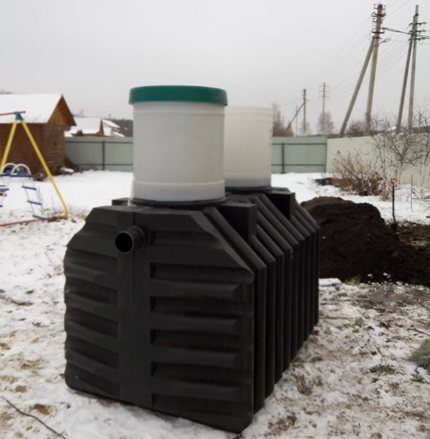
Maintenance regulations for household VOCs in winter
Each septic tank is accompanied by a passport with detailed operating and preventive maintenance rules. Only compliance with these standards guarantees the proper operation of the entire treatment system.
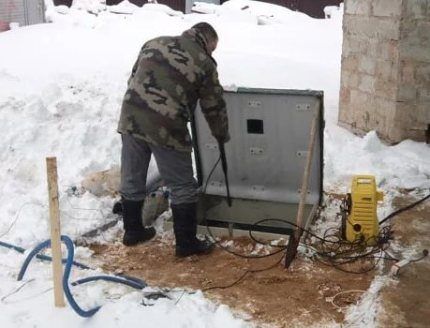
Maintaining an autonomous sewer system in winter is associated with a number of problems.And the main one is low air temperatures outside. After installation, the septic tank is completely buried in the ground, only the lid remains on top.
Usually it is additionally insulated with thermal insulation materials and covered with a layer of soil up to a meter thick.
If the septic tank is installed exactly according to the rules below the freezing level of the soil, then the temperature inside it does not drop to sub-zero levels throughout the year. The ground at depths below the bottom of the septic tank itself freezes only in very cold regions and during severe frosts.
Plus, bacteria that process organic matter create a considerable amount of heat as a result of their vital activity.
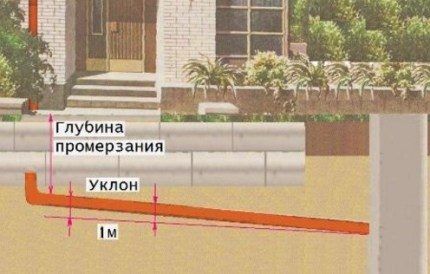
Many septic tank models are designed for operation at street temperatures down to minus 10 °C. In such conditions, they work without problems in winter and are subject to maintenance. In case of stronger frosts, it is better to postpone all preventive measures and cleaning for several weeks until the weather warms up.
Opening the sump hatch in severe frost will lead to sudden cooling and freezing of the water inside, which will inevitably damage the septic tank.
Maintenance rules and process
The main activity when servicing a septic tank is removing excess sediment. For an autonomous sewage system to work optimally and efficiently, the volume of sludge in it must be at the level of 15–30% of the cubic capacity of the metatank.
If there is less of it, then there will be too few microorganisms to fully process wastewater. And if it is more, then there will be too little space for new waters.
To determine the volume of accumulated sludge by eye, you need to stop the septic tank and scoop up liquid from it in a two-liter jar for testing. As the water settles in this container, sediment forms at the bottom. If the grounds end up being more than a third of the can's displacement, then it's time to clean the metatanks.
If the active sludge content is excessive, it begins to thicken, which gradually leads to a decrease in the efficiency of VOCs. Excess sediment must be removed. And it doesn’t matter here whether it’s summer or winter outside at that moment. If the septic tank is needed in working order, it will have to be cleaned regularly.
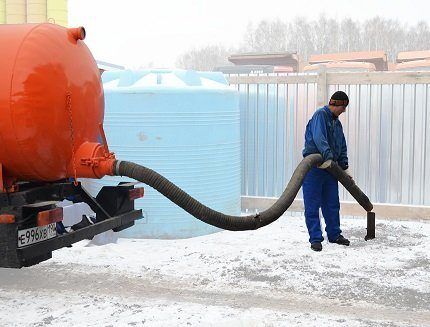
Excess waste sludge is removed for help fecal pump. You can do this yourself by pumping the processed sludge from the septic tank into a compost pit for fertilizers, or you can transfer this procedure to the shoulders of sewer trucks.
Undecomposed organic matter and inorganic sediment must also be removed from the septic tank. In addition, when servicing it, internal pumps, nozzles and elements of the aeration unit are cleaned with clean water.
The full range of VOC cleanup measures includes:
- visual determination of the degree of contamination of the station;
- flushing the chambers and equipment of the septic tank from accumulated sludge;
- cleaning filters and compressor equipment with clean water;
- removal from inside of all solid and non-decomposed remains;
- washing the pipe and hoses inside the installation;
- disinfection of the treatment plant;
- replacing membranes in the compressor;
- adding bioactivators (if the number of microorganisms in the metatank is too small).
At the end of cleaning, the entire complex of equipment is checked for serviceability and correct operation. And then the septic tanks are again filled with water to 80–85% of the total volume.
The hatch cover and its fastenings are also inspected. If there are breakdowns, they will have to be repaired. It wouldn’t hurt to check the correctness of the automation settings that control all processes in the septic tank.
Pumping of wastewater between sections of the settling tank, aeration and mixing of waters must occur according to the technology and program developed by the VOC manufacturer.
Features of operating a septic tank in cold weather
If the equipment is chosen correctly and the sewage system is designed according to the rules, then the septic tank will work properly even at low street temperatures.It just shouldn’t be opened in severe frosts so that the water inside doesn’t freeze from the cold.
By absorbing organic matter in wastewater, microorganisms generate heat. If the tank is closed, then by definition it is not in danger of freezing and failure. Even with a simple VOC, the water inside does not cool below plus 3–5 °C. And when wastewater enters, the temperature even rises to 10–30 °C.
Under such conditions, the bacteria in the activated sludge thrive and continue to process the organic substances entering the metatank.
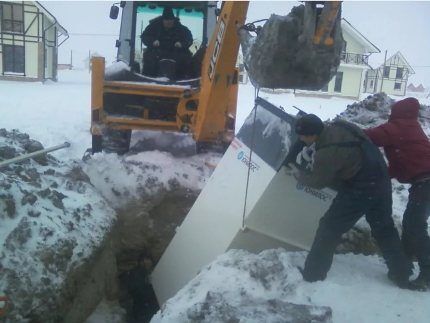
Builders are ready to install septic tanks on their plots all year round. Winter does not interfere with installation work at all. There is only one disadvantage to the winter installation - the higher labor intensity of digging a pit in the ground for a bacterial treatment station for wastewater from a private house.
Among the advantages of installing a septic tank in cold weather are:
- Availability of a large number of free installation teams.
- Reduced groundwater level.
- The ability to install VOCs in a pit dug in floating or crumbling soil.
Technology winter installation of a septic tank no different from summer. Moreover, this applies not only to installation, but also to commissioning and subsequent operation. In winter, the septic tank operates in normal operating mode.
Only in the northern regions will it be necessary to additionally insulate it and the sewer pipe from the house, and how to do this, read this material. And during particularly severe frosts, you should forget about opening the technological hatches so that the cold cannot penetrate inside the sump.
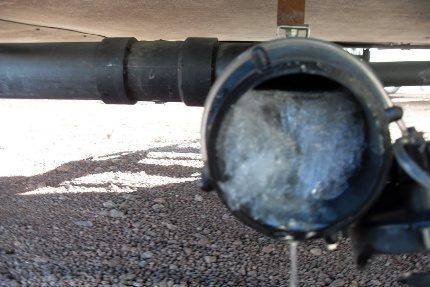
The main vulnerable point in a septic tank in winter is the sewer pipe from it to the house. It is she who freezes most often in cold weather. And then the wastewater simply cannot get from the cottage to the treatment station. To defrost the pipeline, pour hot water into it.
But this method can only help with small ice jams. In other cases, it is better to entrust the restoration of the septic tank to an experienced plumber.
Prevention of clogging and siltation
To with autonomous sewerage If there are no problems in winter, the following simple rules should be followed:
- Do not flush plastic bags, synthetic rags, or other inorganic materials down the drain.
- It is advisable to install filters for rough mechanical cleaning of wastewater before it enters the septic tank.
- It is necessary to minimize the entry into the drain of liquids containing chlorine, acids and alkalis, as well as medications, bleaches and petroleum products.
On the one hand, solid non-bacterial waste can lead to clogged pipes and septic tank systems. On the other hand, there are many liquids that, if they get into VOCs, will lead to the death of the microflora in it. In both cases, the autonomous sewer system will cease to perform its functions.
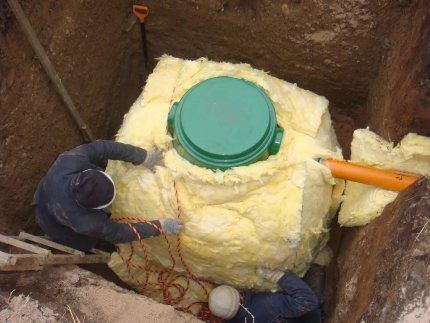
Problems with a septic tank can be associated not only with silting or the death of a colony of bacteria, but also with a narrowing of the drainage pipe leading to it due to clogging with debris. Only help here pipeline cleaning mechanically or hydrodynamically.
Another problem is power outages in aerobic VOCs. Without power supply, the aerator and water pumps do not work. And this is a direct path to sedimentation and stagnation of silt.
If power has not been supplied to the cleaning station with aerobes for several hours, then after the power supply appears, it is worth checking how correctly it works after such downtime. In this case, an unscheduled check will definitely not be superfluous.
What methods can be used to clean a septic tank?
To pump out sludge from a septic tank, you need a fecal pump. You will also need a container for carrying sludge to the compost pit or transporting it for disposal. Cleaning up VOCs with your own hands is a thankless task. It is often better to call a sewer truck. The call costs money, but you don’t have to deal with dirt and waste.
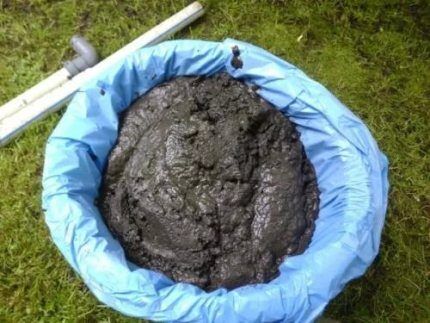
The easiest way to clean interior walls and equipment is with a pressure washer. Doing this dirty work manually is too labor-intensive and time-consuming. And not all silty deposits can be quickly washed off with a rag.
If the septic tank functions as a conventional sewage storage tank, then the wastewater from it can only be pumped into the barrel of a sewage disposal machine. It is prohibited to use them on a personal plot as fertilizer.
However, with a long break between cleanings, this sewage often turns into a viscous fecal mass, which is difficult to pump out. To liquefy it, you will have to pour a special chemical based on nitrates, ammonium or formaldehyde into the container.
Conclusions and useful video on the topic
Rules for preparing an autonomous sewer system for winter:
Details about all the nuances of self-cleaning and maintenance of the TOPAS septic tank:
How to get rid of sludge in a sump tank with your own hands in winter without calling a sewer truck:
There are no particular difficulties in maintaining septic tanks in winter. Cleaning, preventive measures and sludge pumping are carried out according to technological schemes that are also used in the summer. This process is quite dirty, like everything related to sewerage.
Therefore, it is best to entrust it to the specialists of a sewage disposal company. But you can do all the work yourself if you are not afraid of getting dirty in sewage.
Perhaps your opinion differs from that stated in the article? Or do you have personal experience in using and maintaining septic tanks in the winter? Please share it with our website visitors. Leave comments in the block below.




We want to make a septic tank system with filtration fields. Will it work properly in winter? Will the water have time to drain away or will it remain in the soil and build up as ice? The problem is that in winter the system will be used 3 days a week (Friday and weekends).
In principle, if the entire system is installed correctly and with the expectation of operation in winter, then no problems should arise.You need to make sure that the septic tank and filtration fields are buried below the freezing depth of the soil. In this case, the system will maintain the same temperature throughout the year.
If lowering the septic tank and filtration fields to such a depth is problematic, then it is necessary to resort to insulation. As an inexpensive and practical material, I would recommend using extruded foam. This material is not afraid of moisture and is strong enough to withstand the load exerted by the soil layer. The same material can be used to insulate pipes, if necessary.
But I wanted to say that when you start a septic tank in the spring after wintering, then in this case the biological product “Bio Starter” will be very useful to you. This product in the form of bacteria will improve the start-up of the septic tank in the spring. I was personally convinced of the effectiveness of this drug.